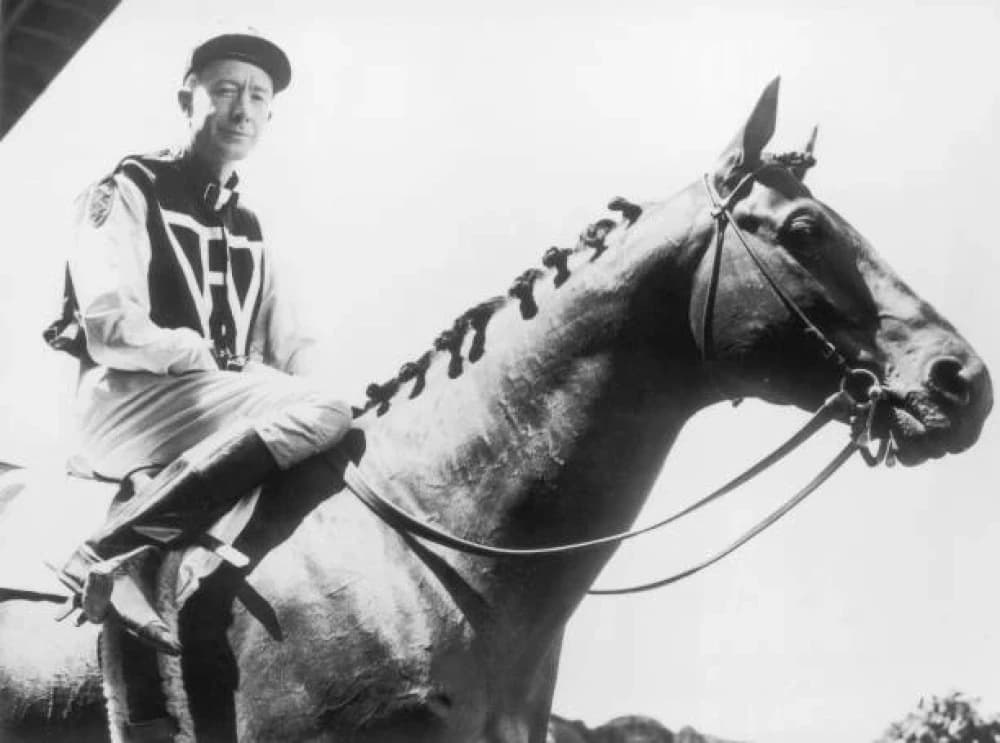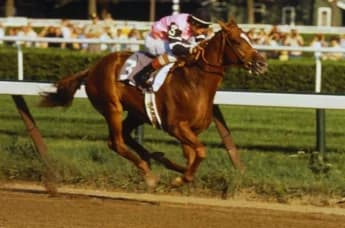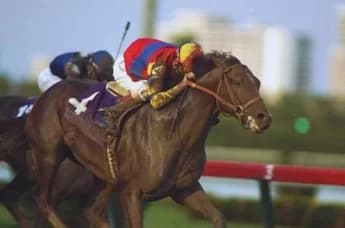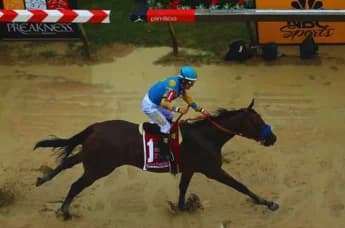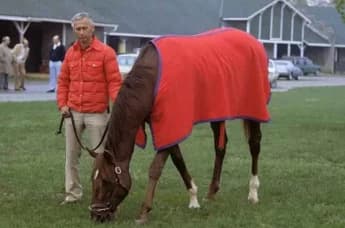Seabiscuit's journey from humble beginnings to racing legend exemplifies the spirit of resilience, capturing the hearts of millions during a challenging era in American history.
Seabiscuit was an American Thoroughbred racehorse whose legacy and narrative extended far beyond the racetrack. Coming from a background of modest means, Seabiscuit emerged as a beacon of hope and a source of inspiration during the Great Depression, captivating not only horse racing fans but also the general populace. Born into less-than-privileged circumstances, he overcame numerous challenges to become one of the most cherished and accomplished racehorses in American history. His story of being an underdog, coupled with his incredible achievements on the racetrack, continues to motivate people even today. Seabiscuit was celebrated for his indomitable spirit, surmounting various obstacles and hurdles, including physical injuries and the doubts of those who questioned his potential.
Significant Achievements in the Career
1935: The Early Days of Seabiscuit: Seabiscuit was born in 1933 at Claiborne Farm in Kentucky, emerging from a lineage that offered little indication of future success. His father, Hard Tack, was an unremarkable racehorse, while his mother, Swing On, had potential but was ultimately not extraordinary. From the outset, Seabiscuit encountered obstacles—he was frequently regarded as too small and too lazy to thrive in race competitions, earning him the label of a 'poor' horse.
1936: Initial Challenges and Transition to Tom Smith: Seabiscuit faced a rough start in his early career, marked by erratic performances and a lack of success. He changed hands multiple times, being sold and transferred to different trainers, but his prospects remained dim. Everything changed when he was brought under the care of trainer Tom Smith in 1936, who saw the potential in Seabiscuit and started to develop him into a champion. With Smith’s patient approach and keen understanding, Seabiscuit gradually revealed his true talents.
1937: A Year of Breakthrough: Seabiscuit’s career began to gain traction in 1937. He achieved multiple victories, including the Brooklyn Handicap, marking his first major win. What truly distinguished him during this time was his evolution into a versatile and competitive racehorse, as he consistently outperformed his rivals, defying the expectations set by his early reputation.
1938—Match Race Against War Admiral: The height of Seabiscuit’s career occurred in 1938 when he faced the formidable War Admiral, the reigning Triple Crown champion, in a much-anticipated match race. This event, taking place on November 1, 1938, at Pimlico Race Course in Baltimore, was sensationally referred to as the 'Match of the Century.' With the entire nation focused on the race, Seabiscuit emerged victorious over War Admiral in front of a packed audience, marking a pivotal moment in both horse racing and American sports history. This win represented more than a mere athletic accomplishment—it symbolized a triumph for the underdog and served as a source of hope for a country grappling with the harsh realities of the Great Depression.
1939: Injury and Recovery: In 1939, Seabiscuit faced a significant challenge when he sustained a leg injury during training. Many feared that this injury would spell the end of his racing career, but Seabiscuit demonstrated his remarkable resilience by making a surprising recovery. Thanks to the expertise of skilled veterinarians and the unwavering support of his dedicated trainer, Seabiscuit was able to return to the racetrack in just a few months, surpassing expectations and reinforcing his status as one of the most resilient horses in the sport.
1940: Victory at the Santa Anita Handicap and Retirement: Following another remarkable year in 1940, Seabiscuit competed in the Santa Anita Handicap, a prestigious race held in California. At that time, it was regarded as one of the toughest races in the nation, and Seabiscuit emerged victorious, achieving one of his most notable wins. Nevertheless, after this triumph, Seabiscuit's racing career came to a close. His owners recognized the strain that years of competition had placed on his body and decided it was the right moment for him to retire.
Retirement and Legacy: Seabiscuit concluded his racing career with an impressive record of 33 victories out of 89 races and earnings totaling $437,730, which was a significant amount during that era. His achievements on the racetrack, along with his narrative of resilience and determination, transformed him into an icon not only within the realm of horse racing but also throughout American pop culture. Even after retiring, Seabiscuit’s legacy flourished as he emerged as a beacon of hope, tenacity, and the strength of faith in overcoming challenges.
BloodHorse and Equibase
Data Metrics:
|
Statistic |
Value |
|
Starts |
89 |
|
Wins |
33 |
|
Seconds |
15 |
|
Thirds |
13 |
|
Earnings |
$437,730 |
Perseverance & Resurgences
The career of Seabiscuit was marked by his remarkable resilience, showcasing his physical stamina as well as his strong mental determination.
Initial Challenges: In his early days, Seabiscuit encountered numerous obstacles. His diminutive size and perceived disinterest in racing caused many to view him as a failure. Throughout the beginning of his career, he was considered lazy, frequently trailing behind his competitors, which resulted in his sale and a series of changes in trainers. However, Seabiscuit's luck shifted when he came under the careful guidance of Tom Smith, whose belief in the horse would soon be proven well-founded.
Injury and Recovery: In 1939, Seabiscuit faced a significant setback when he suffered a serious leg injury that raised concerns about his career. Nevertheless, with the unwavering support of his devoted team, including trainer Tom Smith and jockey Red Pollard, Seabiscuit embarked on an extensive rehabilitation journey. His recovery was nothing short of extraordinary, and upon his return to racing, he displayed a renewed energy and determination. The horse that was once regarded as unfit to compete was now racing at the highest level, triumphing over some of the best competitors in the sport.
The 1938 match race against War Admiral represented a defining moment for Seabiscuit, showcasing his remarkable ability to rise to significant challenges. Faced with skepticism about his chances against the formidable and successful War Admiral, Seabiscuit defied expectations, tackling the pressure and the odds against a Triple Crown winner, ultimately claiming victory. This win transcended mere sports; it became a profound testament to the resilience and spirit of the underdog.
Heritage
A Beacon of Hope: During the Great Depression, Seabiscuit evolved into more than just a racehorse. For millions of Americans facing economic challenges, he symbolized the possibility of overcoming struggles and achieving greatness despite the odds. His victories on the racetrack ignited a sense of hope, and his story of being an underdog provided inspiration for people to come together.
Cultural Icon: The story of Seabiscuit has been etched into history through numerous books, documentaries, and the 2003 film Seabiscuit, featuring Tobey Maguire. This portrayal solidified his reputation as a cultural icon. His journey to stardom not only fascinated horse racing enthusiasts but also captured the interest of the general audience.
Influence on Racing: Seabiscuit had a major impact on horse racing. His achievements attracted considerable attention to the sport, drawing large audiences and generating extensive media coverage. His victories played a crucial role in rekindling interest in racing during a period when the industry faced significant challenges.
Lasting Legacy: Even many years after his passing, the tale of Seabiscuit remains prevalent across different media platforms, and his name continues to symbolize resilience and victory.
Future Perspectives
Although Seabiscuit died in 1947, his legacy is deeply ingrained in the fabric of American sports history.
Ongoing Inspiration: The tale of Seabiscuit continues to motivate not only horse racing enthusiasts but also those beyond the sport. His journey serves as a powerful reminder that true success is not always determined by one’s lineage or societal expectations, but rather by resilience and perseverance.
Celebrations of Legacy: Annual events such as the Seabiscuit Heritage Days at Santa Anita Park honor his legacy and accomplishments, ensuring that future generations will become familiar with the horse who emerged as a national icon. Seabiscuit’s narrative will forever remain one of the most significant in the history of racing, demonstrating how even the most unexpected champions can leave an indelible impression on the world.
Seabiscuit’s Legacy in History: The Seabiscuit Heritage Foundation actively works to maintain his legacy, ensuring that his remarkable story will be shared for many years to come. Through various exhibits, educational initiatives, and commemorative events, Seabiscuit’s name endures, forever honored as a representation of the American spirit.
Although Seabiscuit's racing career concluded in 1940, his impact on the sport of horse racing and on American culture remains significant and enduring, cementing his status as one of the most renowned and inspirational racehorses in history.

